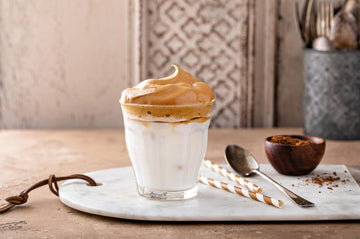A cup of coffee or hot chocolate feels more complete with a creamy, foamy top, and that’s where an electric milk frother comes in. This small appliance whisks milk into a light, velvety texture in seconds, transforming an ordinary drink into something closer to what you’d order at a café.
While it’s often associated with cappuccinos or lattes, a frother can be used with a variety of drinks, both hot and cold. Understanding what it does and how to use it can help you decide if it’s worth adding to your kitchen setup.
What is an electric milk frother and what can it do?
An electric milk frother is a countertop or handheld device designed to aerate milk quickly by spinning a small whisk or using induction heat and agitation. The process incorporates tiny air bubbles into the milk, producing foam with a silky texture. Depending on the model, a frother can heat the milk as it foams, or simply froth it cold for drinks like iced lattes.
What makes an electric frother useful is its consistency and convenience. It removes the trial and error of manual frothing methods, delivering uniform results with minimal effort. With it, you can prepare dense microfoam for lattes, airy foam for cappuccinos, or lightly frothed milk for hot chocolate. Some models even come with multiple settings that let you choose between different textures and temperatures.
Beyond coffee, frothers can be used creatively in the kitchen. They can whip up matcha tea, mix protein shakes, or add foam to cocktails and specialty drinks. For anyone who enjoys experimenting with beverages, an electric frother extends the possibilities well beyond the typical morning cappuccino.
Electric milk frother vs. manual milk frother
When choosing between an electric and a manual milk frother, the biggest differences come down to effort, speed, and consistency. An electric milk frother does the work for you. You press a button, and in under a minute you have hot, foamy milk ready for a latte or cappuccino. Many models allow you to adjust temperature and foam density, which means you can get repeatable results without much skill or guesswork.
A manual frother, on the other hand, requires more physical input. Common types include hand-pump frothers, French press frothers, or handheld whisks. These can create good foam, but the process takes longer and the texture is less predictable. You need to heat the milk separately and then pump or whisk it vigorously to incorporate enough air. This gives you control but can be tiring if you make frothed drinks often.
Durability and maintenance are also worth considering. Manual frothers typically have fewer moving parts and can last for years with minimal upkeep. Electric models, while faster and more versatile, may require descaling, cleaning of internal parts, or eventual replacement if the motor wears down.
Cost is another factor. Manual frothers are cheaper upfront, often less than half the price of electric ones. But if you’re making frothy drinks daily and want consistent foam at the press of a button, an electric frother justifies its higher cost with convenience.
In short, if you enjoy hands-on brewing and occasional foamy drinks, a manual frother works fine. But if you want speed, precision, and ease of use, an electric milk frother is the practical choice.
How to use an electric milk frother
Using an electric milk frother is straightforward, but small details can make the difference between flat milk and café-quality foam. Most models are designed to be intuitive, but following the right steps ensures the best results.
Start by choosing your milk. Whole milk produces the richest, creamiest foam because of its higher fat content. Skim milk creates lighter, airy foam, while alternatives like oat or almond milk can froth well if labeled “barista” versions. Avoid overfilling the frother—each device has a maximum fill line, and going past it usually results in overflow when the milk expands.
Once filled, select the setting. Many electric frothers offer multiple modes, such as hot froth, cold froth, or simply heating without foaming. If your model only has one button, it may cycle through options depending on how long you hold it down. Pay attention to these controls, as the difference between a cappuccino-style froth and a latte-style microfoam often comes down to the selected mode.
When the frothing starts, resist the temptation to open the lid. Frothers are calibrated to spin at specific speeds, and interrupting the process can reduce foam quality. Within 60 to 90 seconds, the machine will stop automatically. At this point, you’ll have warm, foamy milk ready to pour into your coffee.
For best results, swirl the frothed milk gently before pouring. This blends the lighter foam at the top with the denser, steamed milk beneath, creating a uniform texture that integrates smoothly into espresso. If you enjoy latte art, pour slowly from a slight height, then drop the spout lower once the cup is nearly full to shape patterns.
Cleaning is just as important as frothing. Most electric frothers have nonstick interiors, so rinsing immediately after use prevents buildup. Always check if parts are dishwasher safe, but when in doubt, hand-wash with warm soapy water and dry thoroughly. Neglecting cleaning can lead to burnt milk residue, which affects both flavor and machine lifespan.
With consistent practice, an electric milk frother becomes second nature. The combination of correct milk choice, proper filling, and timely cleaning ensures you’ll get smooth, café-level foam at home every time.
How to choose an electric milk frother
Not all electric milk frothers are built the same, and selecting the right one depends on how you plan to use it. Some people want quick, no-fuss froth for a daily cappuccino, while others may want more control over texture and temperature. Here are the key factors worth considering before buying:
Capacity
Pay attention to how much milk a frother can handle in a single cycle. Most models hold between 4 to 8 ounces for frothing and 8 to 12 ounces for heating. If you’re making drinks just for yourself, a smaller unit saves space and works efficiently. For families or frequent entertaining, a larger-capacity frother avoids the hassle of multiple batches.
Frothing Options
Some machines only create hot froth, while others allow both hot and cold foaming. Higher-end models even offer multiple textures, such as dense froth for cappuccinos or silky microfoam for lattes. Think about the drinks you enjoy most. If you like experimenting with iced lattes or matcha, having a cold foam option is valuable.
Heating Control
Not all frothers are precise when it comes to temperature. Overheating can scald the milk, leaving a burnt taste. Look for models with automatic shutoff or adjustable heat settings. The ideal milk temperature for frothing is around 140–150°F—warm enough to enhance sweetness without breaking down proteins.
Speed and Efficiency
Time matters when you’re rushing in the morning. A good frother should complete its cycle within 60–120 seconds. Some cheaper options may take longer or produce inconsistent foam, so balancing speed and quality is important.
Build Quality and Materials
Nonstick interiors make cleaning much easier, but the coating should be durable and resistant to peeling. Stainless steel designs often last longer and maintain temperature better. A transparent lid is also useful to monitor the process without opening the device.
Noise Level
While electric frothers are quieter than steam wands, some can still produce noticeable whirring. If you live in a small apartment or make coffee early in the morning, look for a low-noise model.
Price vs. Features
Basic frothers are inexpensive and do the job for simple cappuccinos, but investing in a mid-range or premium option can provide versatility and durability. Consider how often you’ll use it—daily coffee drinkers usually benefit from a sturdier model with more control.
Ease of Cleaning
Frothers that fully disassemble or have dishwasher-safe parts simplify maintenance. Others require careful hand-washing. If you know you’ll struggle with consistent cleaning, choose a design that minimizes effort.
When comparing options, it helps to ask: Do you want a reliable everyday machine for one type of coffee, or do you want versatility to prepare different drinks and milk textures? The right choice will save time, improve consistency, and elevate the overall coffee experience at home.
Bringing café foam home
An electric milk frother may seem like a small gadget, but it has the power to change your daily coffee ritual. With the right model, you can produce café-style lattes, cappuccinos, and even cold foams without leaving your kitchen. Choosing one that fits your routine—whether you prioritize speed, control, or versatility—ensures every cup tastes balanced and satisfying. Once you find the right frother, your morning coffee won’t just be a drink; it’ll be a ritual worth looking forward to.





